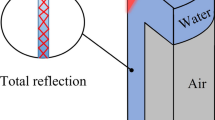Abstract
In dealing with fluid impact and large deformation problems by traditional Lagrange grid, calculation failure often happens due to grid distortion. An abrasive water jet machining model is created to simulate the whole stage by software LS-DYNA from the jet into the nozzle to the workpiece material removal process using ALE (Arbitrary Lagrange–Euler) algorithm. The mesh for the abrasive and water is based on the ALE formulation, while the target mesh applies the Lagrange formulation. The effect of jet penetration is implemented by coupling the grids of ALE and Lagrange. The jet traverse speed is achieved by definition of the movement of ALE grid to reduce the mesh domain. The abrasive constitutive equations are also presented in this paper. The uniform mixture for abrasive and water is achieved by definition of volume percentage of the two materials in the initial ALE elements. Simulation results give the relationships between processing parameters and the cutting depth. The good agreement between simulation results and experimental data verifies the correctness of the simulation.
Similar content being viewed by others
References
Van Luttervelt CA (1989) On the selection of manufacturing methods illustrated by an overview of separation techniques for sheet materials. CIRP Ann Manuf Technol 38(2):587–607
Bostjan J, Daniel B, Mihael J (2004) Monitoring of abrasive water jet (AWJ) cutting using sound detection. Int J Adv Manuf Technol 24:733–737
Ramulu HM, Kunaporn S, Arola D, Hashish M (2000) Water jet machining and peening of metals. Press Vess Technol 122(1):90–95
Parikh RJ, Lam S (2009) Parameter estimation for abrasive water jet machining process using neural networks. Int J Adv Manuf Technol 40:497–502
Kovacevic R, Fang M (1994) Modeling the influence of the abrasive water jet cutting parameters on the depth of cut based on fuzzy rules. Int J Mach Tools Manuf 34(1):55–72
Momber AW (1995) A generalized abrasive water jet cutting model. Proceedings of the 8th American Water Jet Conference, Vol. 8, Houston, pp 359–371
Parikh PJ, Lam SS (2009) Parameter estimation for abrasive water jet machining process using neural networks. Int J Adv Manuf Technol 40:497–502
Bitter JGA (1993) A study of erosion phenomena: part I. Wear 6:5–21
Wang J (1999) Abrasive water jet machining of polymer matrix composites cutting performance, erosive process and predictive models. Int J Adv Manuf Technol 15:757–768
Johnson GR, Bsissel SR (1996) Normalized smoothing functions for SPH impact computations. Int J Numer Math Eng 39:2725–2741
Johnson GR, Stryk RA, Beissel SR (1996) SPH for high velocity impact computations. Comput Methods Appl Mech Eng 139:347–373
Liu H, Wang J, Kelson N, Brown R (2004) A study of abrasive water jet characteristics by CFD simulation. J Mater Process Technol 153:488–493
Li M, Rong HB, Yi MG (2008) Water jet penetration simulation by hybrid code of SPH and FEA. Int J Impact Eng 35(9):1035–1042
Eltobgy MS, Elbestawi MA (2005) Finite element modeling of erosive wear. Int J Mach Tools Manuf 45:1337–1346
Kyriaki M, Thomas K (2007) A finite element based model for pure water jet process simulation. Int J Adv Manuf Technol 31:933–940
Paul S, Hoogstrate AM, Van L, Kals HJJ (1998) Analytical and experimental modeling of abrasive water jet cutting of ductile materials. J Mater Process Technol 73:189–199
Liu GR, Liu MB (2003) Smoothed particle hydrodynamics: a meshfree particle method. World Scientific Publishing Co., Singapore
Gwanmesia GD, Zhang J, Darling K, Kung J, Li BS, Wang LP, Neunille D, Liebermann RC (2006) Elasticity of polycrystalline pyrope (Mg3Al2Si3O12) to 9 GPa and 1000°C. Phys Earth Planet Inter 155(3-4):179–190
Hassan SI, Chen C, Kovacevic R (2004) On-line monitoring of depth of cut in AWJ cutting. Int J Mach Tools Manuf 44(6):595–605
Author information
Authors and Affiliations
Corresponding author
Rights and permissions
About this article
Cite this article
Wenjun, G., Jianming, W. & Na, G. Numerical simulation for abrasive water jet machining based on ALE algorithm. Int J Adv Manuf Technol 53, 247–253 (2011). https://doi.org/10.1007/s00170-010-2836-7
Received:
Accepted:
Published:
Issue Date:
DOI: https://doi.org/10.1007/s00170-010-2836-7




